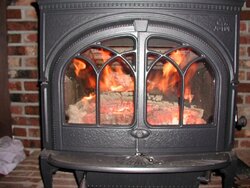- Feb 5, 2007
- 10
I've had a Oslo for two seasons now. Very pleased with it EXCEPT for the primary air control. It doesn't seem let in enough air to get the stove really going with the door(s) closed - need to leave the side door cracked until it really, really gets going and secondary combustion takes off. If it dies back, crack a door and it picks right up. It's not a problem for me, but wife can't quite get the hang of it...
Chimmney is ~18' SS lined masonary, I inspected it (again) last week and it's clean and clear from top to bottom. Draft is excellent, can almost be too much if it gets windy out.
Stove has been like this since new. I've checked the passages under the primary air inlet and they're clean. Wondering if the 3, 1/4" holes in the primary air housing(inside the front door) are the restriction or if it's elsewere in the stove?
Is this a known "problem" with these stoves?
I burn mainly well seasoned Oak and Maple, some Locust.
Chimmney is ~18' SS lined masonary, I inspected it (again) last week and it's clean and clear from top to bottom. Draft is excellent, can almost be too much if it gets windy out.
Stove has been like this since new. I've checked the passages under the primary air inlet and they're clean. Wondering if the 3, 1/4" holes in the primary air housing(inside the front door) are the restriction or if it's elsewere in the stove?
Is this a known "problem" with these stoves?
I burn mainly well seasoned Oak and Maple, some Locust.



